Because a language that's mostly dead is still slightly alive.
Don't wanna be here? Send us removal request.
Video
Since I was asked: the two signs being repeated are SAL (munus, woman) and GI/GE (qanû, reed), in a Neo-Assyrian script. Probably they're just two random signs for practice. However, there is a slight possibility that this is a Fantastic Four reference ("Mrs. Reed" = Sue Storm?).
The video is at least a few years old, so who knows. But square-based chopsticks are indeed how I was taught to write cuneiform, too!
i never realized cuneiform was made with the corner of a cuboid tool, i thought the wedge shapes were carved such that you would press straight down with the tool at a 90° angle to the clay
198K notes
·
View notes
Note
Hello! I was wondering if you had any tips for using cuneiform as an art inspiration? One of my friends is super into cuneiform and birds, so I wanted to kind of write the cuneiform for "corvid" using stylised triangular crows.
Feel free to ignore this, it's a pretty involved ask!
I had a look at the Assyrian Languages website, and it spat out

but there's so many options! Why is the translation given as "erebu" without the cuneiform, then followed by the other words "uga" and "buru", which do have cuneiform?
And are there rules for rearranging the different units of the word? Is it like English, where you can't really split the letters of a word up, because it won't make sense?
I also double-checked the translation with the the Concise Dictionary of Akkadian, which you linked a couple posts ago, and they match, but there isn't any cuneiform in the dictionary.

Thank you for reading this far!
Okay, buckle up for a ride!
Akkadian is a Semitic language with a weird, cobbled-together writing system. It's a bit like a rebus: we can figure out that "👁️ ❤️ 🐑" means "I love you," because "eye" sounds like "I," hearts connote love, and a female sheep is a ewe, which sounds like "you." Likewise, a given cuneiform sign can be one of three things: a syllabogram (representing the sound of particular syllables, like 👁️), a logogram (representing a particular idea, like ❤️); or a determinative (representing a category of ideas, like "Dr."). In many cases, a given sign could be any one of those, depending on context. As a result, there are many possible ways to spell most words—although certain sign combinations tend to get standardized in a particular place and time.
In this case, "UGA" is the logogram for a corvid, and "MUŠEN" is the determinative for a bird. So one way to write "a crow" (literally "a crow-bird") would be to combine the signs for UGA and MUŠEN. (MUL is the determinative for an astral body, so if you were trying to say "the crow-planet," you could write it as "star-crow-bird," or "MUL.UGA.MUŠEN."). And yes, the order does matter in most cases; I wouldn't rearrange them.
But! Instead of writing something logographically, you could "spell it out" using syllabograms. So the word erēbu/arēbu, which is what "crow" would have sounded like, can be broken down into syllables and spelled that way, e.g. a-re/ri-bu. When the Epic of Gilgamesh describes sending out a raven as part of the Flood story, it spells it as "a-ri-bu." (Well, technically a-ri-ba/a-ri-bi, because those are the declined forms.)
The simplest two options that appear in the corpus, then, are UGA or BURU4 ("crow" without the "bird" determinative, which is optional) or a-ri-bu. Here's what those look like, using two different potential writing styles: Old Babylonian (an earlier and more complex writing system) and Neo-Assyrian (a more rectilinear, streamlined, later writing system):

As you can see, UGA is a very complicated sign, so I would recommend choosing either BURU4 or a-ri-bu. I find Neo-Assyrian much easier to reproduce, but the choice of writing system is up to you.
I hope this helps. Send me a picture of what you produce; it sounds so fun!
107 notes
·
View notes
Note
Happy to help!
Enki is indeed the name of a Sumerian god, one of the main three gods (An, Enlil, and Enki). He was a water-god associated with the Apsu, the cosmic groundwater from which the world came, and with "wisdom" (which entailed practical skills, knowledges, and magical power). He is usually identified with Ea, the Akkadian god with similar domains (just as Zeus was identified with Jupiter).
Enki's name comes from the two common Sumerian logograms EN and KI. EN means "lord, ruler," but KI is a little more difficult to translate. It can mean "earth, ground," but it really means more broadly "the world below heaven" and can also refer to the Underworld. Because his domain was the groundwater and the earth it suffused, Enki was seen as the most accessible of the three major gods. His association with wisdom/magic meant he was frequently invoked in incantations.
In the image below, taken from the British Museum cylinder seal BM 89115, we see Enki with one foot on a mountain, streams of water and fish flowing out from his shoulders.
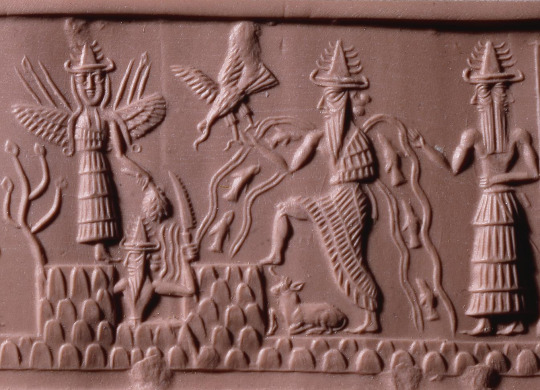
There's a lot more info here. If you have any further questions, let me know. You've got a very cool and venerable name!
Hi! This is a little far-fetched considering your niche is not linguistics or names (feel free to redirect me!), but I was wondering if you knew/knew where to find any specific information about the name Enki? It's my name (just about), and it's a little weird since literally nobody's heard about it, and looking around online I can't seem to find much reputable information aside from the god Enki and Enkidu's name, and I also don't know enough about Mesopotamia to be able to make cultural links or anything, and whether the name and derivatives originated from the god (and so the meaning is from there) or if there's a different source.
It doesn't have a specific meaning irl, my parents gave it to me bc they didn't want me to share a name with anyone else at school, and it's annoyingly superficial enough I've never had a strong connection to it. But idk, it'd be nice to at least know what it represents.
Thank you in advance! (And apologies if this is way out of your realm or anything!!)
hi! my apologies, this is absolutely way out of my scope of knowledge BUT i know a guy
@mostlydeadlanguages perhaps you can answer or direct anon to sources they could look into? thank you ^^
287 notes
·
View notes
Note
Hello! I have a deep interest in mesopotamian history and linguistics. I am not a professional at all, however. It is just a hobby of mine. I wanted to know if you were aware of any dictionaries for akkadian words (preferably online resources) that are reliable. When I search "akkadian dictionary" this website is the first to appear: https://www.assyrianlanguages.org/akkadian/index_en.php
However, I am not sure how reliable it is because it does not have a clear author/authors or credentials. Would you happen to know anything about it? And if there are other resources, could you please link them?
Thank you!
Hello! That dictionary is handy for quick lookup, but as you say, I don't know where they're getting the information from, so I would be a bit dubious. The sine qua non of Akkadian dictionaries is available for free online: the Assyrian Dictionary of the Oriental Institute of the University of Chicago (CAD). Unfortunately, it's available only as PDFs for each initial letter, and the older letters are poorly OCRed, so searching it can be tedious and manual.
A good in-between option is the Concise Dictionary of Akkadian (CDA), available as a PDF here.
Best of luck with your studies!
135 notes
·
View notes
Note
Heya! I'm looking at the famous Complaint Tablet to Ea-Nāṣir and I'm having difficulty with one part of the Akkadian. Specifically, lines 16 through 18: ya-ti a-na ki-ma ma-an-ni-im / tu-ši-im-ma ni-[x-x-x]-ma / ki-a-am te-me-ša-an-ni. I get that the first line is "me, like what sort of person" and the last line is "you treat me so badly", but I'm lost on the one in between. Is this a verb like "wašāmum" or something? And what might the damaged word be? Tyvm!
In my translation, I translated those lines loosely as "Are you really going to treat me this way, insulting me like that?" Here is the hand drawing of them:
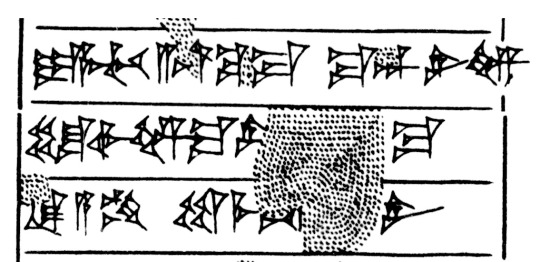
Word-by-word, this is how I'd translate it:
iāti ana kīma mannim: "me, like what kind of thing..." tu-ši-im-ma-ni-[i]-ma: "... are you treating me?" kī'am tumêšanni: "how you despise me!"
CAD parses the middle line as a single verb, a shin-stem durative of the trebly weak verb ewû, plus a first-person suffix and the -ma coordinating conjunction, and I agree.
The tricky part is that the first half of that line is inscribed quite densely, so there's definitely space for more than an "i" in the missing area in the center, which is why your transcription has space for three signs there. But on the other hand, the "ma" has lots of space around it, so it's possible that the scribe began writing densely, then realized that they had lots of space, so they spaced out the "i-ma" signs at the end of the line. Since the text makes sense with the single sign, I'm inclined to stick with the CAD (and Leemans, whose transliteration agrees).
Let me know if you have follow-up questions!
79 notes
·
View notes
Note
Hello, I wonder do you still accept asks? Because me and my friends kinda self-taught myself on Akkadian recently and there's passage that kinda... sparked debates among my peers. I can't find the cuneiform but the Akkadian sounds like this :
ü-tu-lu-ma etlütu (gurus) [sa i] - [na ma] -a-a-al mu-si sal-lu
Professional Assyriologist (Andrew George) translated that passage as :
The men were lying down, that were asleep on beds for the night
From the Akkadian dictionary we can identify some words
Utulu : [itulu] lay down
Etlutu (gurus) : Young men
Mu-si : at night
Sal-lu : sleep
Other words are too fragmentary for the admittedly amateur me to decipher, but I can't find any usual word for bed in that passage either "bitu" (bedroom), "erim", "gisnu", "huralbu", "i'lum", "marsu", or any other possible words for bed that you can find on the dictionary, let alone the proof that the word is plural. The closest I can find is, perhaps, that [na ma] there is a fragmentary word for "namallu" which in dictionary means "plank bed", double-sided bed. And also I can't find plural form on that line, so perhaps you can help me? Not necessary about the bed/beds, but more about how will you translate that line?
Hi! The fragment you mention is from the SB Epic of Gilgamesh, VI.180. Here is the score for that line (a comparison of various manuscripts):

Although the second line is a little different, we can use it in combination with the other versions to reassemble the likely original line: "ú-tu-lu-ma GURUŠ.MEŠ šá i-na ma-a-a-l mu-ši ṣal-lu." Whenever you see a double "-a-", as in "ma-a-a-l," it's generally transliterating a y/j sound, so it's listed in the dictionary as either "majālu" or "mayālu" (depending on how German your dictionary is!). "Majālu" is a relatively common Akkadian word for a bed or sleeping place. It's rendered in version 1 as "majāl" (no case ending) because "ina" will often occur with the bound (i.e. stripped-down) form of. noun.
So the word-for-word literal translation is "and-they-lay-down, the-young-men, in bed, at-night, sleeping."
Hope that helps, but let me know if you have further questions!
33 notes
·
View notes
Text
On Foxes

eṭlu ša sibbat nēši iṣbatuni ina nāri iṭṭubu ša sibbat šēlebi iṣbatuni ussēzib "The man who seized the lion’s tail sank in the river; he who seized the fox’s tail was saved." — ABL 555 r.3-6 (Neo-Assyrian cuneiform letter, date and name missing)

πόλλ' οἶδ' ἀλώπηξ, ἀλλ' ἐχῖνος ἓν μέγα “The fox knows many things, but the hedgehog one big thing.” (Archilochus, 7th c. BCE)

“We communicate like the burrows of foxes, in silence and darkness, under ground.” — Henry David Thoreau, letter to Ralph Waldo Emerson, February 12, 1843

“Be like the fox who makes more tracks than necessary, some in the wrong direction. Practice resurrection.” — Wendell Berry, “Manifesto: The Mad Farmer Liberation Front,” 1970
134 notes
·
View notes
Note
hi! I'm the asker who was looking to translate some Aramaic
so, I have a pretty good knowledge of Latin, and I was looking through graffiti from ancient Pompeii, and I found one (sexual in nature, as a warning I guess) with a string of letters that didn't make sense to me:

oblinge mentula, mentulam elinges, mtcloftorgc, destillatio me tenet
I found a journal article that says this is transliterated Aramaic, but unfortunately refuses to translate it due to the graffiti's sexual nature:

I'm just curious to know what it says, I guess it could end up being useful to a presentation I'm working on about Latin sexual vocabulary, but honestly I kinda just Wanna Know
I was curious too! Unfortunately, my answers are less than satisfying.
The first word (tiqlōf) is straightforward: "(you, masc.) strip off." But I'm stumped by the second word těrōgīk ("your [fem.] trog"). The only meaning I can find for trog is "etrog," a type of citrus fruit with a thick, bumpy, yellow rind. The etrog was occasionally compared to a breast (specifically, it has a "nipple" at one end), but it's hardly a common euphemism.
So if this is Aramaic, then it probably means something like "strip off your etrog," i.e. "expose your breast." But I am a little dubious, as is this Twitter/X thread on the phrase. Mysterious!
30 notes
·
View notes
Text
I don’t post here much lately because I’m busy, well, doing actual Academic Writing. But I thought y’all might enjoy this piece that I wrote about Purim and Esther/Ishtar and reading the Bible as fan fiction. (This is what my next book is going to be about.)
Happy Purim to all who celebrate!
135 notes
·
View notes
Text
Coriander and Clay: A Sapphic Cottagecore Romance
Blake has spent her career translating cuneiform tablets, but this one is different: an ancient collection of recipes. To decode them, she turns to a local chef whose prickly demeanor conceals her painful history. Side by side, they spend a summer experimenting with flavors of the past—and sizzling chemistry in the present. But when the tablet reveals a secret that could transform the world of Assyriology, will the bond they've built withstand the fallout?
Chasing trends...
"... and as that’s happening, BookTok is going to be like, “Hey, you know what’s hot now? Cottagecore Mesopotamian Cookbook Fiction.” Which isn’t a thing yet, but who the fuck knows? It sounds great, whatever it is. We get Big Feels and Earnest Confessions and Weird Ancient Soups!"
As someone who has, in various contexts, written a) cottagecore, b) foodie romance, and c) Mesopotamian fiction, I feel like this is a trend that I should leap onto.
You'd read it, right?
159 notes
·
View notes
Text
Chasing trends...
"... and as that’s happening, BookTok is going to be like, “Hey, you know what’s hot now? Cottagecore Mesopotamian Cookbook Fiction.” Which isn’t a thing yet, but who the fuck knows? It sounds great, whatever it is. We get Big Feels and Earnest Confessions and Weird Ancient Soups!"
As someone who has, in various contexts, written a) cottagecore, b) foodie romance, and c) Mesopotamian fiction, I feel like this is a trend that I should leap onto.
You'd read it, right?
159 notes
·
View notes
Note
Hey! How are you? I hope you're doing great!
May I have a translation from these cuneiform writings? :) I'm dying to know what it's written there. I'm trying to make out a few things here and there, but it's quite puzzling to fathom, to say the least. Anyhow, if you're able to do it, I'll be more than appreciative and thankful for it. Thank you
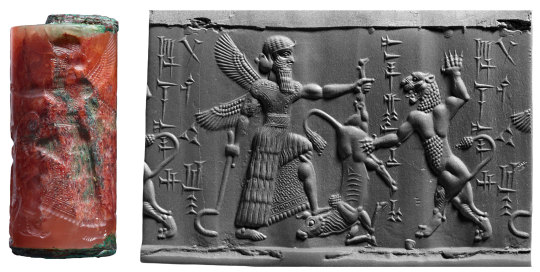
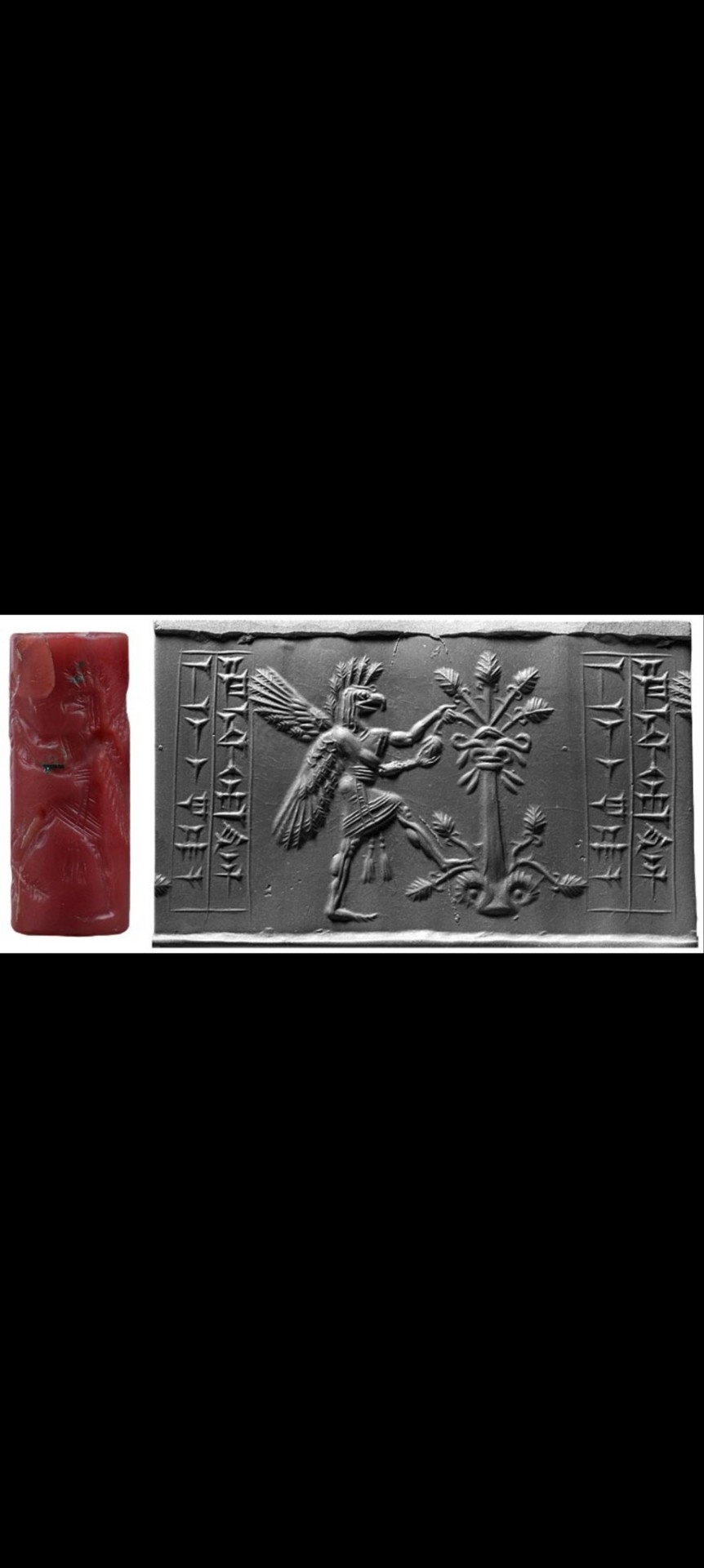
What beautiful seals! It looks like you've come across Morgan Seal 747 and Morgan Seal 609. (Click through for more discussion.) A full write-up of the seals, including their inscriptions, is in CANES 1 by Edith Porada, which unfortunately I don't have access to. Aruz et al also talk about the first seal in Assyria to Iberia at the Dawn of the Classical Age.
The inscriptions appear to be identifying the owners of the seal. The first seal is inscribed (according to Aruz et al) with "[belonging] to Nabu-nadin-shumi son of Ashur … may [the god] Nabu grant [him] life!" The second seal mentions a man named Ashur-iddin.
I hope you'll forgive me leaving things there. It's the start of my first semester as a professor, I don't have CANES to reference, and my cuneiform-reading skills are rusty. Anyone else want to jump in?
96 notes
·
View notes
Text
Thanks!! It's so fun to see that this is making the rounds again in the wake of Season Two.
The names are made up, but the etymologies are real. That's why I made comments about how the names were "rare," because they aren't actually attested for real Mesopotamians. They just come from real Akkadian roots.
A Letter from “Crawly” to Azirapil
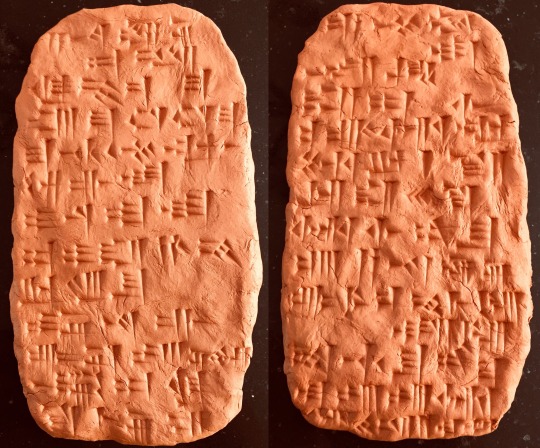
This remarkable letter of unknown provenance surfaced recently in the cuneiform collection of the University of West Wessex. Addressed to Azirapil from a Mr. “Crawly,” it appears to be begging for the other’s return to Ur from a western journey with another individual, Abiraham. The relationship between the two (brothers? business partners? friends?) is unknown, and all three names are quite unusual. The letter also mentions a Mr. Ea-naṣir in Ur; if this is the same Ea-naṣir as the merchant mentioned in UET V 22, 29, 71, and 81, then the original letter would be dated to the Larsa period, around 1800 BCE. However, this particular copy appears to be a scribal exercise; the writing is relatively unskilled, and the cuneiform is Neo-Assyrian in form. It is unclear whether the text is based on a historical letter, or if its unusual names and content were invented for scribal practice.
Text:
Tell Azirapil [1]:
Thus says “Crawly” [2]:
When will your time in the West be finished? Abiraham [3] seems very dirty, and I am weary [4] in Ur. [There is] a talented mirsu-maker [5] on Wide Street!
Watch out, for I have acquired a new friend. His name is Ea-Naṣir [6], and I may play wickedly with him if you do not return.
Come quickly!
Keep reading
30K notes
·
View notes
Text
Mostly this post is an excuse to show off my new check mark, because of COURSE I had to get it.
But I suppose I should announce that my sporadic posts are about to get even more sporadic, for a very good reason: I will be starting next month as a tenure-track professor of Hebrew Bible!
I still would not recommend going into ancient languages as a career; there are far far fewer jobs than there are brilliant people who want them. But somehow, miraculously, I managed to win one of the few ones out there. I feel absurdly lucky.
(And of course I also feel grateful to everyone who has interacted with my posts here; this blog made a huge difference in helping me to feel part of a community of ancient nerds! Love you all.)
167 notes
·
View notes
Note
Hello! What text is TCL 6 49 r.13-29 (referring to Lamashtu) referring to specifically? Thank you :)
"TCL" stands for "Textes cunéiformes du Louvre," "6" means that it's from the 6th volume of publications of those texts, and "49" means that it's the 49th text in that volume.
You can learn more about the text on its CDLI page here or its Louvre page here. Let me know if you need any further information!
(For reference, my translation is here.)
27 notes
·
View notes
Text
Good question!
The short answer is: it didn't. Shamash as the word for the sun/Sun-god is well-attested in almost every Semitic language. It's in Hebrew, too: shemesh means "sun."
But shamash, meaning "helper"—specifically used for the ninth "helper candle" in a Hanukkah menorah—is a much later development. It comes from the verb shamash, which first appears in post-biblical Hebrew, like the Mishnah and Talmud. According to Jastrow (and it seems reasonable to me), shamash is a shin-stem of the older Hebrew verb mashash, which means "to touch or handle." Since Semitic shin-stem verbs are generally causative, shamash would therefore mean "to cause to handle, i.e. to minister or officiate." From there, it became the noun shamash: "one who ministers or attends to someone." It probably wasn't used in the context of a candle until the 16th century.
So in this case, the two words converged from different directions. Both are spelled the same in consonantal Hebrew—שׁמשׁ—but they originally derive from different roots.
(And why is it pronounced shemesh instead of shamash in Hebrew? Because it's a segolate noun, a noun that once ended in a double-consonant cluster, and Hebrew gives those e-sounds to make them easier to pronounce.)
An Incantation Against Depression (VAT 13697)
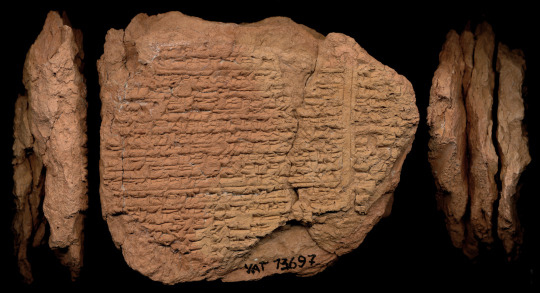
This is an excerpt from a lengthy Akkadian ritual that we know from multiple tablets, all of them unfortunately broken. The ritual starts by describing the patient: he is constantly depressed and has other physical symptoms, from pain to nausea. Such symptoms are clearly a sign that he has been attacked by witchcraft. To combat the witchcraft, the ritual practitioner relies on a combination of magical actions (such as burning figurines of the magicians who caused the illness) and prayers to Shamash, the Sun-god, who represents an all-seeing force of justice.
This is the first of the incantations recited by the practitioner. Below the cut, I’ve included the transliteration of the incantation (in case anyone wants to try it) and a short comment on the untranslated word ��Namraṣit.”
I call to you, Shamash. Listen to me! Accept my sleepless sighing. Learn swiftly of the suffering that seizes me. I am sluggish; I am sleepless; I am exhausted; I am anxious. I focus on Namraṣit, your light, o my lord. Shamash, lord of justice, to you I turn. Pay attention to my lifted hands; listen to my speech. Listen to me; accept my petition; judge my case; decide my verdict.
Keep reading
789 notes
·
View notes
Note
I saw your blog and I think you might be able to help with something I've been failing to get anywhere with for a while! I'd like to get a tattoo of a line from one of Enheduana's hymns to Inana, but while I've managed to find translation, transliteration and references, I don't have the research chops to find the original cuneiform, which is what I really want.
The one I'm after is translated as "To rove around, to rush, to rise up, to fall down and to ...... a companion are yours, Inana." (Line 116 of 'A hymn to Inana (Inana C)') in the Electronic Text Corpus of Sumerian Literature.
Any chance you could hook me up?
Here's what I've got.
The tricky thing here is that the "original cuneiform" is dense and written in 3D, which makes it difficult to duplicate in a tattoo if you're just operating off a photo. But you can find photos of this text on the CDLI here, if you scroll down, to give you a sense of the problem.
A simpler route is to "cuneify" the values of the cuneiform symbols, i.e. to convert them into standardized Unicode symbols. Those will be much easier to copy. This is, I think, the line you want, in syllabic cuneiform:
𒌨 𒊒 𒌨 𒌌 𒇻 𒌌 𒍣 𒄑 𒍣 𒄖 𒊒 𒄭 𒀭 𒋫 𒋛 𒋛 𒋼 𒀭 𒈹 𒍝 𒀀 𒄰
(You'll need to install a cuneiform font for it to display right.)
All that said, for something to be tattooed permanently on your body, you want to be certain it's correct—and at the end of the day, I only have expertise in Akkadian, not Sumerian. (They're completely different languages that share a cuneiform writing system.) I would highly advise checking with @sumerianlanguage or another Sumerologist before you get anything inked.
41 notes
·
View notes